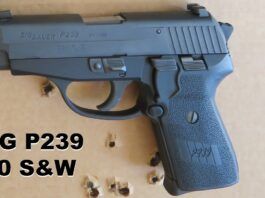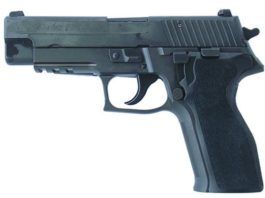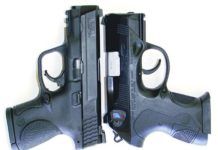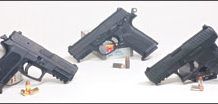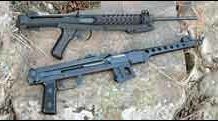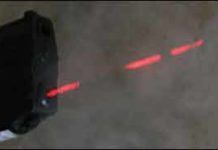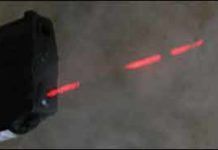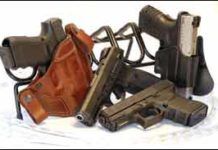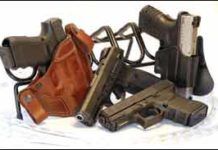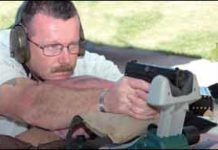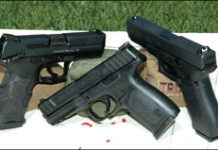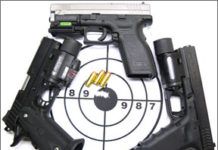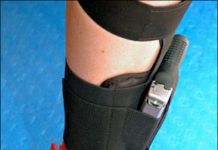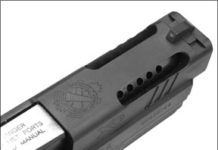Smith & Wesson M&P40c Vs. Berettas Storm Compact Forty
What is there to say about two 40-caliber handguns that never stuttered? A lot. There are significant differences between the handguns that lead us to believe one is the superior defensive handgun, at least for our testers. When faced with an attack by a psychopath with no sense of the moral dimension of his crime, we wish to be as well armed as possible. Unfortunately, society frowns on an individual walking around with a shotgun slung over the shoulder. Or, a full-size service pistol may become a drag on the hip. This means that the compact handgun is a popular compromise. Among the most popular concealed-carry types is the compact 40 S&W pistol.
The term subcompact is applied to those handguns with both a short barrel and slide and a shortened grip, both of which have significant downsides. The shorter barrel generates less velocity. The shorter grip prevents an ideal firing grip. The smaller grip helps some shooters, but it depends upon the individual's hands and determination in practice. So to see how these and other performance factors are handled, we looked at a pair of subcompact handguns: The Smith & Wesson Military & Police Compact M&P40c 109203 40 S&W, which lists for $569, but which we found at CheaperThanDirt.com for $480. The Beretta Px4 Storm SubCompact JXS4F20FC 40 S&W was $511, also from CTD, with a list price of $582.
The primary difference between the two was their actions. The Smith & Wesson is a double action only. The trigger press is reset by the slide, and it is the same press for each trigger pull. The Storm features a double-action-first-shot trigger. A long press of the trigger fires the first shot. The slide cocks the hammer in recoil and the following shots are single action. Notably, the person using a double-action-first-shot handgun must learn two trigger actions. In our view, it takes less training time to master the DAO trigger, but there is an argument for the superior accuracy of the single-action trigger press.
Also notable, these 40-caliber handguns demonstrate more recoil than their 9mm counterparts, due to them expelling more bullet weight and bullet energy. In a self-defense scenario, we always want more energy on the target, if the shooter can put the bullet on the target. However, we recommend that anyone considering the 40-caliber compact handgun should take time to master the 9mm first. We found these handguns are significantly more difficult to use than 9mm compacts we've previously tested.
Three More Midsize Forties: SIG, FNH-USA, and Walther
To expand the coverage of 40 S&W semi-automatics we have tested recently, our test team recently looked at three midsize pistols we thought would be worthy challengers to the Glock 23 Gen4 40 S&W, $650, evaluated in the May 2013 issue. In that test, our team gave the G23G4 an A grade, effectively setting a standard for other pistols in this category to try to reach. So we threw an array of other pistols at it, going from a budget discontinued model (the FNH-USA FNP-40 No. 47832, $450), to a longtime competitor (SIG Sauer's SP2022 No. E2022-40-B, $570), to a model introduced in 2011, about a year after the Gen4 was released (Walther PPQ No. 2776481, $680.)
The latest three polymer test pistols have similar stats for size and weight, but fit, feel, function, and design varied greatly, with the last consideration playing more of a role than we initially expected. To recap why we graded the Glock so highly two months ago, we noted that the different back-strap contours allow the owner to easily find the best fit for his or her hands. The grips allowed good control. The Glock had a minimum of controls, rivaled in this test only by the PPQ, which had a trigger safety like the Glock and just ambi slide releases beyond that. The Glock's magazine release was reversible, a feature duplicated on the FN and SIG guns, and possibly topped by the two trigger guard mag-release levers on the PPQ. The Glock sights had a wide, square, U around the rear notch and a white dot on the front, while the newest guns all had three-white-dot sight arrays.
Dimensionally, the guns were close in size. In overall length, the numbers were 7.2 inches for the Glock, 7.4 inches for the SIG, 7.25 inches for the PPQ, and 7.4 inches for the FN. Overall heights (measured from the top of the sights to the bottom of the magazine or magazine extension) were Glock 5.0 inches, FN and PPQ (5.4 inches), and SP 5.5 inches. The barrels were all right at 4.0 inches (Glock, Walther, FN), or nearly so, 3.9 inches for the SIG. Loaded weights were 32.1 ounces for the 13+1 Glock, 33.6 ounces for the 12+1 Walther, 37.0 ounces for the 12+1 SIG, and 37.2 ounces for the FN, which partially reflects its larger capacity of 14+1. Functionally, during our shooting, we had perfect reliability from all the pistols.
Elsewhere, the Glock had a tactile loaded-chamber indicator in the form of a slight step on the extractor that could be easily felt with the (right-hand) trigger finger, with a similar feature duplicated on the PPQ and FN. On top of the G23, the slide was smooth enough not to cut the hands during clearance drills, and the new guns were likewise dehorned, except for their sharp sights. Takedown was simple, and likewise easy on the FN and SIG, but much more complicated on the PPQ. Workmanship inside all three guns was excellent, just as it was on the outside. Thus, these midsize guns were more than a match physically for the Glock, but would they bring positive individual differences to the fray and overcome the Austrian? We find out below.
Two Pieces of Firearms History: Sterling, Pioneer Arms Compete
We acquired two historical and technically interesting firearms for this test. The guns were the 9mm Wise Lite Arms Sterling L2A3 9mm, about $500, and the Inter Ordnance/Pioneer Arms PPS-43C Pistol chambered in 7.62x25 Tokarev, also in the $500 range. The latter is officially a pistol because its folding stock is welded in the folded position. We found the folding stocks do nothing for their handling or practical function, but in close quarters that might be a handy feature. Both designs originally fired from an open bolt, and the Sterling was originally selective fire. These two test guns are both manufactured to fire semiauto-only, and they both fire from a closed bolt. We managed to find three types of 9mm ammo and two brands of 7.62x25 Tokarev, enough to wring out both guns. Here's what we found.
Pocket Pistols with Factory Lasers: Walther, SIG, and Ruger
Pocket Pistols with Factory Lasers: Walther, SIG, and Ruger
New Polymer Forties: Glock, Springfield, Ruger Shoot It Out
The 10mm pistol cartridge was developed to fill the gap between 9mm and 45 ACP firepower. In 1989 its popularity was spurred by the FBI choosing 10mm as its favored caliber. At the time, Colt successfully chambered a 1911 for 10mm, the Colt Delta Elite. Smith & Wesson tried to adapt its line of semi-automatic pistols as well. Durability became an issue. But then pistol makers found out it was easier to increase the strength of their 9mm fleet to handle another round developed almost concurrently, the 40 S&W round, rather than tool up to withstand the more powerful 10mm rounds. We could resort to revolver jargon and refer to 10mm ammunition as 40 Magnum. That's because both 40 S&W and 10mm ammunition share the same diameter bullet, but the 10mm case is 0.140 inch longer.
Time has not quite eclipsed the standard 10mm round, but it is now decidedly less popular than the 40 S&W it sired. The big reason: the 40 S&W delivers noticeably more power than the 9mm, but the larger high-velocity round can still be packed into same frame as current 9mm pistols with little structural change.
This brings us to our current roster of test guns. The Ruger SR40 began life as a 9mm pistol, and since our test of the SR9 in the December 2007 issue, a compact version is now available in both calibers. Likewise, the roots of the Glock 23 Gen4 can be traced to the 9mm Model 19, which itself was the compact version of the G17 service pistol. The Springfield Armory XDM40 Compact is somewhat of a hybrid with characteristics of both a compact and full-size pistol. Developed from a foreign-manufacture 9mm service pistol, the XDM Compact offers a shortened grip for better concealment and a full-length 16-round magazine that includes a grip extension. Our fourth pistol is a true subcompact, and it shoots the same bullet as our other test guns but from a longer case that packs more powder. The Glock Model 29 chambers 10mm ammunition, from which 40 S&W was developed. Since the 10mm originally lost favor due in part to its recoil, we wondered how much we'd like shooting the round in such a small package as the G29.
New Polymer Forties: Glock, Springfield, Ruger Shoot It Out
The 10mm pistol cartridge was developed to fill the gap between 9mm and 45 ACP firepower. In 1989 its popularity was spurred by the FBI choosing 10mm as its favored caliber. At the time, Colt successfully chambered a 1911 for 10mm, the Colt Delta Elite. Smith & Wesson tried to adapt its line of semi-automatic pistols as well. Durability became an issue. But then pistol makers found out it was easier to increase the strength of their 9mm fleet to handle another round developed almost concurrently, the 40 S&W round, rather than tool up to withstand the more powerful 10mm rounds. We could resort to revolver jargon and refer to 10mm ammunition as 40 Magnum. That's because both 40 S&W and 10mm ammunition share the same diameter bullet, but the 10mm case is 0.140 inch longer.
Time has not quite eclipsed the standard 10mm round, but it is now decidedly less popular than the 40 S&W it sired. The big reason: the 40 S&W delivers noticeably more power than the 9mm, but the larger high-velocity round can still be packed into same frame as current 9mm pistols with little structural change.
This brings us to our current roster of test guns. The Ruger SR40 began life as a 9mm pistol, and since our test of the SR9 in the December 2007 issue, a compact version is now available in both calibers. Likewise, the roots of the Glock 23 Gen4 can be traced to the 9mm Model 19, which itself was the compact version of the G17 service pistol. The Springfield Armory XDM40 Compact is somewhat of a hybrid with characteristics of both a compact and full-size pistol. Developed from a foreign-manufacture 9mm service pistol, the XDM Compact offers a shortened grip for better concealment and a full-length 16-round magazine that includes a grip extension. Our fourth pistol is a true subcompact, and it shoots the same bullet as our other test guns but from a longer case that packs more powder. The Glock Model 29 chambers 10mm ammunition, from which 40 S&W was developed. Since the 10mm originally lost favor due in part to its recoil, we wondered how much we'd like shooting the round in such a small package as the G29.
Paired Foreign 40 S&W Pistols: H&K USP LEMs Duel Steyrs
In our March 2011 issue we paired small-framed revolvers designed for concealed carry with larger-framed wheelguns in hopes of defining an effective battery of defense for home and street. In this test we've taken a similar tack by pairing full-sized 40 S&W pistols with a compact version of each pistol. All four pistols were based on a polymer frame with staggered-column magazines for higher capacity.
Our first pair was from Steyr Arms. They were the new 4-inch-barrel M-A1 pistol and the compact model S-A1 with 3.62-inch barrel. Both guns carry a suggested retail price of $642. These guns were much like the Steyr pistols imported several years ago that performed favorably in a test published in the April 2001 issue. Among the changes to the latest Steyr pistols was a shorter-action trigger.
We matched the Steyr pistols against a pair of Heckler & Koch USP pistols that offered a trigger system unfamiliar to most shooters. Devoid of safety or decocker levers, our $952 USP and $991 USP Compact Variant 8 pistols each utilized a full-time double-action trigger referred to as the LEM, aka Law Enforcement Module.
One significant difference between our comparison of the revolvers and the pistols in this story was that the delineation between house gun and carry gun was not as clear. The bigger revolvers were fitted with long 6-inch barrels for maximum sight radius and greater propulsion of the bullet. Their weight also played a part in recoil control. The small-framed revolvers were built to be as light and as small as possible, with priorities such as recoil control and shooter comfort further down on the list. In the case of the pistols in this story, one might choose a duo of big and small as we intend, but then again the capacity and power of the compact pistols may be enough for use as a primary gun.
In choosing our test guns, we thought we had done a good job of picking two equal teams. But we soon realized that the lack of a Picatinny rail on the Heckler & Koch USP pistols might cause buyers to shy away. To level the playing field, we found a $10 adaptor listed under the Laser Legacy menu on the LaserLyte website. We then purchased one of Laserlyte's new Subcompact V3 lasers. Smaller than a matchbook and priced at only $99, we could think of no excuse not to have one.
Full-size pistols are often tested for accuracy from the 25-yard line. Most forums test compact pistols from 15 yards. We decided to split the difference and test all four guns from the 20-yard bench. Here is why. We reasoned that what little knowledge of the bigger guns we would gain from the extra 15 feet would be overshadowed by finding out how hard we could push the compact pistols. We wanted to know how much accuracy we were giving up by switching to the compact models. For support, we used the $60 Caldwell Matrix shooting rest from www.battenfeldtechnologies.com. We augmented the Matrix with sandbags to support our elbows, forearms, and head. Yes, we even piled sandbags beneath our test shooter's chin. The guns were easy to stabilize in the Caldwell rest, but we didn't want the shooter's eyes shifting as the head bobbed around in the crosswinds. The only thing moving in this set up was the trigger finger.
We did not expect the compact guns to be as accurate as the full-size models. All four pistols had full-length dustcovers, but the smaller guns offered a limited area on which to rest the guns. Another key element was reduced sight radius. We also wondered if the shorter grip of either compact pistol would be a factor.
Test ammunition consisted of Winchester USA 165-grain FMJ target ammunition and two hollowpoint defense rounds. The defense loads were the Remington UMC 180-grain JHP rounds sold in 100-round value packs and a new round from DoubleTap ammunition topped with a 150-gr. Nosler JHP bullet (www.doubletapammo.com). In addition to our bench rest session, we also performed a rapid-fire action test from the 7-yard line using the 165-grain rounds. The target was an IPSC Metric target offering a rectangle measuring about 5.9 inches by 11 inches in the center and a "head" area measuring about 6.3 inches by 6 inches above. Beginning with the gun in both hands pulled in towards the chest (finger off the trigger), our military/LE tester fired two shots to center mass and one to the head over 10 separate strings of fire. We recorded first shot elapsed time as well as overall elapsed time and looked for a total of 30 hits on target, including 10 shots to the head.
40 S&W Polymer Pistols: H&K, Glock, S&W Shoot It Out
High-Capacity 40 S&W Rail Guns: Glock, Springfield, & STI
The 40 S&W has become the preferred cartridge for much of the law-enforcement community because it's more powerful than the 9mm, recoil that's snappy but not as substantial as the 45 ACP, and magazine capacities than split the difference between the two. This month we'll look at three guns that fit this medium-frame high-capacity format. They could aptly be classified as "tactical" pistols, because they all featured an accessory rail capable of adding a weapon light and/or laser.
Our contenders consisted of two polymer-framed guns, the Springfield XD40 ($605) and the newly introduced Glock G22 RTF2 ($599). Both guns incorporated striker-fired systems with trigger-tab designs. The third gun came from Georgetown, Texas. The STI Tactical 4.15 operates like a 1911 but utilizes a double-stack magazine to dramatically increase ammo capacity. Designated as a 2011 frame, the Tactical 4.15 is built on a patented modular platform, and incorporates a wealth of performance upgrades. All of the bells and whistles come at a price, however. Occupying the highest price point of our test guns, the Tactical 4.15 comes in at a wallet-clutching $1999 MSRP.
We conducted our testing within the friendly confines of Bass Pro Shops in Grapevine, Texas. The climate-controlled indoor pistol range was ideal shelter from the sweltering heat and one particularly nasty thunderstorm that blew up during one of our sessions. Accuracy ratings were done at 10 yards using a slow, controlled trigger press. We then progressed to multi-round firing at 8 and 15 yards. Magazine changes were made during the middle of some of our runs to see how each gun handled in a more stressful environment.
Three More Ankle Guns: Kahr, Springfield, and Walther 40s
In the July 2009 issue of Gun Tests, we evaluated three small revolvers chambered for 38 Special. These guns were chosen specifically as candidates for concealment inside a holster strapped to the ankle. In this test we will look at three semiautomatic pistols suitable for ankle carry or other deep concealment. Each of the guns in this test are chambered for 9mm or 40 S&W, but we went with the bigger round here. Our test guns are the $786 Kahr PM40 No. 4043 40 S&W, Walther PPS No. WAP10002 40 S&W, $713; and the Springfield Armory Enhanced Micro Pistol No. PI9240LP, $1329. Despite their small sizes, these guns are as pricey as many popular full-size models. But if it comes down to drawing a gun from deep concealment, at least you can take comfort in knowing you're not about to depend on a cheap pistol. In fact, all three guns completed our tests without malfunction.
For testing in the summer heat we arrived at Phil Oxley's Impact Zone, located in Monaville, Texas, at daybreak (theimpactzonerange.com). The shade of a cypress tree and a steady breeze helped us keep cool as we practiced firing each gun standing offhand and from the bench before attempting shots of record. Then we fired five-shot groups from sandbag support to establish accuracy from the 10-yard line. We also engaged two different action tests that we hoped would tell us more about each gun's capability when fired standing without support.
First, we tried our familiar test of delivering two shots to the center of an IPSC metric target followed by a single shot to the head area of its humanoid silhouette. Center mass on the target consisted of an A-zone measuring 6.0 inches wide and 11.0 inches tall. The head area measured 6.25 inches by 6.75 inches overall, with another A-zone measuring 4.0 inches by 2.0 inches to designate a preferred area of impact. After an audible start signal, the elapsed time of each shot was displayed by an electronic timer. Ten separate strings of fire were recorded. Test distance was 7 yards.
Our second action test also required three shots per draw but only to the center of the target. Instead of holding the gun in both hands, the shooter utilized only his strong hand (right hand only for a right-handed shooter or left hand only for the left-handed shooter). In each case the start position was holding the gun pulled back toward the chest with little more than the muzzle at the bottom of the shooter's vision. Upon start signal, the gun was thrust toward the target.
Our list of test ammunition consisted of four different loads. For our bench session we fired Winchester USA's 165-grain FMJ rounds and two choices from Black Hills. They were remanufactured loads (sold in blue boxes) topped with a 180-grain FMJ bullet and Black Hills new manufacture 180-grain jacketed hollowpoints packed in red boxes. For our action test, we relied upon Black Hills new manufacture 155-grain JHP rounds to help us paint a picture of how each gun might perform filled with defensive ammunition when rapid fire was called for. Here is what we learned.


























